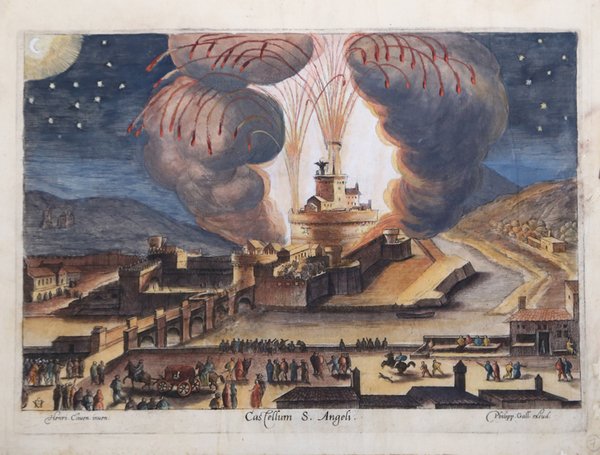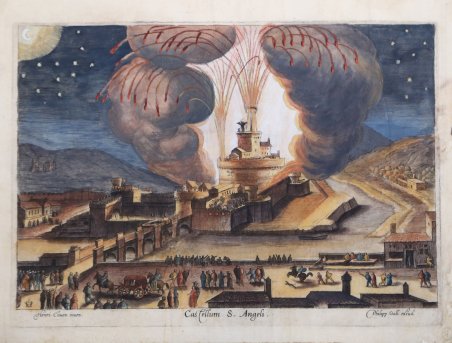Veduta tratta dalla raccolta Ruinarum varii prospectus, ruriumque aliquot delineationes pubblicato da Philip Galle con incisioni tratte da disegni di Hendrick van Cleve o Cliven III. Figlio e allievo di William van Cleve, si trasferisce in Italia nella metà del XVI secolo; oltre ad un dipinto raffigurante una veduta di Roma, datato 1550, realizza un cospicuo numero di disegni che serviranno come modelli per l’opera incisa, realizzata al ritorno ad Anversa e pubblicata nel 1587. Le vedute, che raffigurano principalmente Roma ma anche altre città europee, recano in basso l’iscrizione “Henri. Cliven. inven." o "Henri Cliven pingebat" che ne attestano la derivazione ma non l'autografia. È certo che Hendrick viaggiò in Italia. Gli studiosi non sono d'accordo sui tempi del suo soggiorno, che alcuni collocano prima del 1551, anno in cui divenne maestro della Gilda, mentre altri lo collocano tra il 1551 e il 1555, data in cui si sposò. In Italia fece molti disegni di vedute di montagne, edifici e paesaggi urbani, che poi utilizzò nelle sue opere. Sulla base dei suoi disegni noti di città italiane, probabilmente trascorse del tempo a Roma, Firenze e Napoli. Hendrick van Cleve era un artista di paesaggio, creando sia vedute topografiche che paesaggi immaginari. I suoi paesaggi sono in stile italianizzante e tipicamente raffigurano ampie vedute con rovine che possono essere o meno interamente immaginarie. Le rovine sono di solito una compilazione di elementi caratteristici dell'architettura classica. Alcune sono basate su rovine esistenti che possono essere identificate, mentre altre sono costruzioni completamente di fantasia dell’artista. I disegni di Hendrik van Cleve furono quindi usati dai tipografi contemporanei di Anversa. Due serie di stampe secondo i disegni di van Cleve furono pubblicate dal famoso incisore ed editore Philips Galle. La prima serie, Regionem, rurium, fundormumq[ue], varii atove amoeni prospectus fu pubblicata nel 1587. Consiste di 10 tavole che raffigurano principalmente paesaggi pastorali immaginari con rovine. Hendrik van Cleve è menzionato come disegnatore su ogni stampa e Philip Galle come incisore. La seconda serie intitolata Ruinarum varii prospectus, ruriumq[ue] aliquot delineationes non è datata ma fu probabilmente pubblicata intorno allo stesso periodo della prima. Le 38 stampe mostrano vedute mediterranee. Non è chiaro chi abbia inciso questa serie. La firma con il monogramma di H. van Cleve appare su tutte le 38 incisioni, ad eccezione dell'incisione n. 22 della serie. Anche la firma di Philip Galle appare su tutte le incisioni mentre quella di suo figlio Theodoor appare solo su una. Anche Hendrick van Cleve stesso potrebbe essere stato l'incisore della serie. Incisione al bulino, finemente colorata a mano, alcune pieghe di carta perfettamente restaurate, per il resto in buono stato di conservazione. A nice view taken from the rare Ruinarum vari prospectus ruriumq. Aliquot delinationes. Hendrick van Cleve or Cliven III, son and pupil of William van Cleve, moved to Italy in the second half of the XVI century; besides a painting depicting a view of Rome (1550), he realized a considerable amount of drawing which he afterwards used as preparatory for the engravings he realized in Antwerp and published by Philip Galle in 1587. The views, whose main subject is Rome but there are also other European cities, bear the inscription “Henri. Cliven. inven" or "Henri Cliven pingebat" on lower part, which testify their origin, but not necessarily the fact that he realized them. It is certain that Hendrick travelled to Italy. Scholars disagree about the timing of his stay in Italy. Some place it before 1551, the year in which he became a master of the Guild, while others place it between 1551 and 1555, the date on which he got married. In Italy he made many drawings of mountain views, buildings and cityscapes, which he later used in his works. Based on his known drawings of Italian cities, he likely spent time in Rome, Florence and Naples. Hendrick van Cleve was a landscape artist. He created topographical views as well as imaginary landscapes. His landscapes are in the Italianising style and typically depict wide views with ruins that may or may not be entirely imaginary. The ruins are usually a compilation of characteristic elements from classical architecture. Some are based on existing ruins which can be identified. Others are completely fabricated constructions Hendrik van Cleve's drawings were used by contemporary printmakers in Antwerp as designs. Two series of prints after van Cleve's designs were published by the renowned engraver and publisher, Philips Galle. The first series, Regionem, rurium, fundormumq[ue], varii atove amoeni prospectus was published in 1587. It consists of 10 plates that mainly depict imaginary pastoral landscapes with ruins. Hendrik van Cleve is mentioned as the designer on each print and Philip Galle as the engraver. The second series entitled Ruinarum varii prospectus, ruriumq[ue] aliquot delineationes is undated but was likely published around the same time as the first one. The 38 prints show Mediterranean views. It is not clear who engraved this series. H. van Cleve's signature and monogram appear on all 38 engravings with the exception of engraving n.22 of the set which lacks the monogram. Philip Galle's signature also appears on all the engravings while that of his son Theodoor appears on engraving only. Hendrick van Cleve III may also have been the engraver as his monogram is present on the print. Engraving, with fine later hand colour, some paper fold perfectly restored, otherwise good conditions. Cfr. Hollstein, F. W. H. Dutch and Flemish Etchings, Engravings, and Woodcuts, v.4, pl.170, n.1-38 and v.7, p.80, n.423-460.


Scopri come utilizzare
Scopri come utilizzare

